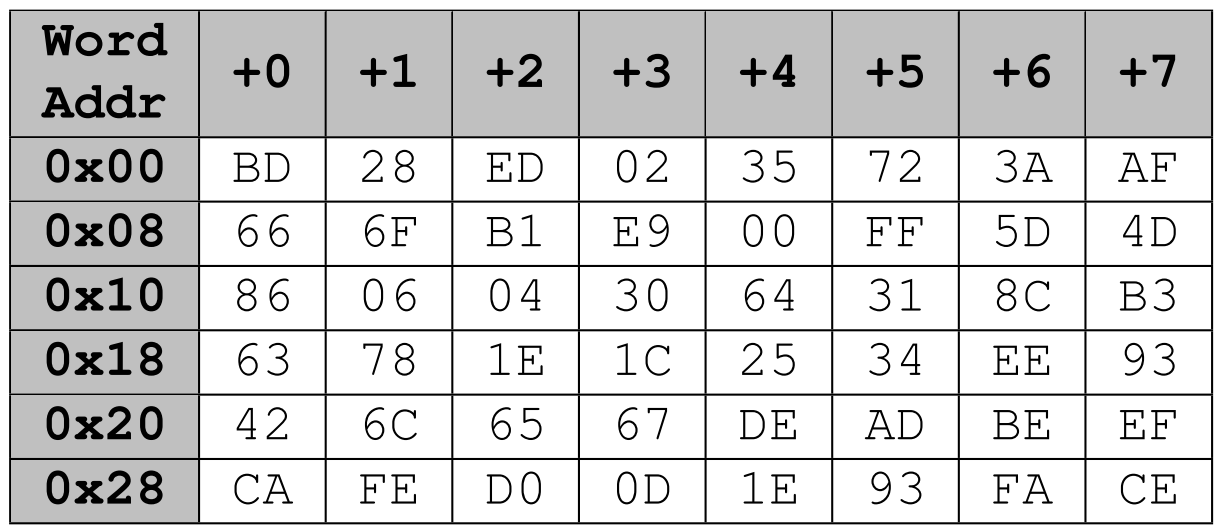CS 208 s21 — Review Worksheet SOLUTIONS
Table of Contents
1 Number Representation
Consider the binary value 0b110101:
- Interpreting this value as an unsigned 6-bit integer, what is its value in decimal?
25 + 24 + 22 + 20 = 32 + 16 + 4 + 1 = 53
- If we instead interpret it as a signed (two's complement) 6-bit integer, what would its value be in decimal?
-25 + 24 + 22 + 20 = -32 + 16 + 4 + 1 = -11
- Assuming these are all signed two's complement 6-bit integers, compute the result (leaving it in binary is fine) of each of the following additions. For each, indicate if it resulted in overflow.
| 0 | 0 | 1 | 0 | 0 | 1 | ||
|---|---|---|---|---|---|---|---|
| + | 1 | 1 | 0 | 1 | 1 | 0 | |
| Result: | 1 | 1 | 1 | 1 | 1 | 1 |
Overflow? No
| 1 | 1 | 0 | 0 | 0 | 1 | ||
|---|---|---|---|---|---|---|---|
| + | 1 | 1 | 1 | 0 | 1 | 1 | |
| Result: | 1 | 0 | 1 | 1 | 0 | 0 |
Overflow? No
| 0 | 1 | 1 | 0 | 0 | 1 | ||
|---|---|---|---|---|---|---|---|
| + | 0 | 0 | 1 | 1 | 0 | 0 | |
| Result: | 1 | 0 | 0 | 1 | 0 | 1 |
Overflow? Yes
| 1 | 0 | 1 | 1 | 1 | 1 | ||
|---|---|---|---|---|---|---|---|
| + | 0 | 1 | 1 | 1 | 1 | 1 | |
| Result: | 0 | 0 | 1 | 1 | 1 | 0 |
Overflow? No
2 Bitwise

- What happens when we fix/set one of the inputs to the 2-input operators? Let
xbe the other 1-bit input. Fill in the following blanks with either0,1,x, orNOT x:x & 0= 0
x & 1= x
x | 0= x
x | 1= 1
x ^ 0= x
x ^ 1= NOT x
- Bit Extraction: Returns the value (0 or 1) of the 19th bit (counting from LSB). Use
>>and&.int extract19(int x) { return x >> 18 & 0x1; }
3 Pointers
For this problem we are using a 64-bit x86-64 machine (little endian). The current state of memory (values in hex) is shown below:

Write the value in hexadecimal of each expression within the commented lines at their respective state in the execution of the given program. Write UNKNOWN in the blank if the value cannot be determined.
int main() { char *charP; short *shortP; int *intP = 0x00; long *longP = 0x28; // The value of intP is: 0x 00 00 00 00 00 00 00 00 // *intP 0x 02 ED 28 BD // &intP UNKNOWN // longP[-2] 0x 93 EE 34 25 1C 1E 78 63 charP = 0x20; shortP = (short *) intP; intP++; longP--; // *shortP 0x 28 BD // *intP 0x AF 3A 72 35 // *((int*) longP) 0x 67 65 6C 42 // (short*) (((long*) charP) - 2) 0x 10 }
4 Assembly
- Write an English description for each of the following instructions:
x86 instruction English equivalent movq $351, %raxMove the number 351 into 8-byte (quad) register "rax" addq %rdi, %rsiAdd the 64-bit value of %rdi to %rsi movq (%rdi), %r8Move the 64-bit data at the address stored in %rdi to %r8 leaq (%rax,%rax,8), %raxCompute 9 * %rax and store the 64-bit result in %rax - Consider the following x86-64, (partially blank) C code, and memory diagram. Addresses and values are 64-bit. Fill in the C code based on the given assembly.
foo: movl $0, %eax L1: testq %rdi, %rdi je L2 movq (%rdi), %rdi addl $1, %eax jmp L1 L2: ret
int foo(long* p) { int result = 0; while (p != NULL) { p = (long*) *p; result = result + 1; } return result; }
- Follow the execution of
fooin assembly, where0x1000is passed in to%rdi. Write the values of%rdiand%eaxin the columns. If the value doesn't change, you can leave it blank. Continue writing the next instruction and any changed values until you have traced the full execution (i.e., reachedret).instruction %rdi(in hex)%eax(decimal)movl0x10000 testqjemovq0x1030addl1 jmptestqjemovq0x0addl2 jmptestqjeretaddress value 0x10000x10300x10080x10200x10100x10000x10180x00000x10200x10300x10280x10080x10300x00000x10380x10380x10400x10480x10480x1040